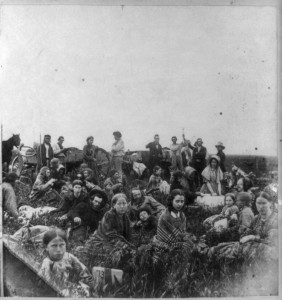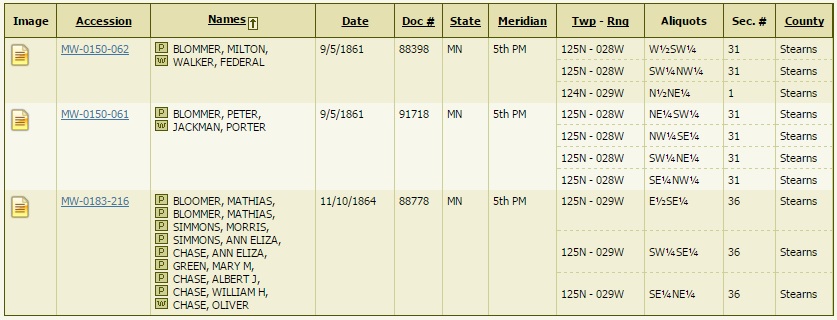When we last examined the Kreifels family, we learned how the two Kreifels brothers (Herman and Sebastian) married two Blommer sisters (Anna Margaretha and Anna Gertrude). The families were living in Osage County, Missouri near the small town of Loose Creek.
I’m not entirely sure about why the Kreifels and Blommer clans left Missouri en masse in 1855. Mathias Blommer, the father of Anna Margaretha and Anna Gertrude, wrote in one of his letters to Germany that living conditions were “unhealthy” in Missouri. He noted that almost all of his brother Heinrich’s children died at a young age from disease.
So for the second time in his life, Mathias Blommer packed up his entire extended family – now including sons-in-law and grandchildren – and this time traveled by wagon train to Minnesota. The journey took seven weeks. I do not know what information or connections he had about Minnesota. According to the Wikipedia article about Stearns County, “the first large immigration was of German Catholics in the 1850’s.”
Mathias’ letters show that he was a pretty smart guy and was always cultivating whatever connections he could. Somehow he had heard about opportunities for Germans in Minnesota and he jumped at the chance to once again make a better life for his family.
Steans County was officially organized in 1855, the same year that the Kreifels and Blommers arrived, and three years before Minnesota even became a state of the union. I’m not sure what process may have been in place for securing land. Mathias said in one of his letters that they were in Minnesota for three years before they officially acquired land:
…the homestead law the first year that we were here in Minnesota was not yet publicized or promoted. After we were here three years the land was opened to the market and had to be immediately paid for. I and our Peter and Melchior had each claimed 160 acres of prairie land. Our John was at that time in California digging for gold. Also in addition, we purchased 160 acres of brush land. So we had at the same time to pay for 640 acres of land at $1.25 an acre.
The records from the Bureau of Land Management show that Mathias made his homestead application in 1864, but it seems likely that his claim dated back at least five years earlier.
Meanwhile, the Kreifels brothers also went about acquiring land from the government:
I have much work to do in researching these land ownership records.
The period between 1855 and 1865 was a very scary time in Minnesota. I find it very curious that Mathias makes no mention of it in his letters. In fact, I think he deliberately covered it up to sugar-coat life in America! The problem was Indian uprisings. The “Dakota War of 1862” swept across Minnesota and although Stearns County was not the epicenter, settlers were definitely affected – either through direct contact or by the widespread fear and panic that was prevalent.

From the book, “Stearns County and the Dakota War of 1862” by Vincent P. Botz:
When the attacks occurred, the settlers lived in fear of the Indians. They would gather at one home and stand guard all night long so their families would not be massacred. This was not only a practice in Stearns County but throughout Minnesota. Inevitably, however, people would leave the relative safety of their fortified cabins to check on their livestock and dwellings and get killed in the process. It was dangerous to be alone during those frightening weeks of the Uprising and there was some safety in numbers. Men would leave in groups to do harvesting with some men only standing guard.
Even though Mathias declined to talk about it, Kreifels descendants remembered their ordeals with the Indians and passed down the stories. Here are some excerpts from the “Kreifels Family Book” (by Marjorie Kreifels Smallfoot, 1985).
At first, there was an uneasy relationship between the German settlers and the Indians:
The family lived in a dug-out. There were many Indians living near. Many times after the mother baked bread, the Indians would ride up to and many times into the dug-out demanding food. The family was very poor and sharing with the Indians caused hardship.
Later, things turned violent:
…he [Peter, son of Sebastian] shared the memory of an Indian raid and hiding with his father, brothers and sister along a creek. His daughter Mabel recalled his telling about hiding in a hollow tree.
There were other hardships besides the Indian troubles. Sebastian’s wife Anna Gertrude died in September, 1864, leaving him with five children under the age of 10. Herman and his wife Anna Margaretha helped care for the motherless children. Within a few years, Sebastian decided to leave the unhappiness behind. He’d heard rumors of excellent land available in Oklahoma and packed up all the kids and left.
Herman and Anna Margaretha stayed a little while longer but back-to-back cold winters prompted them to consider moving farther south. In 1869, they moved to Otoe County, Nebraska. (It’s interesting to note that my own great-great-grandfather, Jöns Mårtensson, was in Minnesota in the spring of 1869 and also concluded that it was too cold. Like the Kreifels, he too decided to leave for Nebraska. He ended up in Saunders County.)
Mathias stayed behind. He had moved his family twice – once from Germany to the United States, and a second time from Missouri to Minnesota. Perhaps he didn’t have it in him to make another move. And in the end, maybe he made the right call. The Indian uprisings ended, warmer weather returned, and he and his other children who stayed in Minnesota became prosperous farmers.


